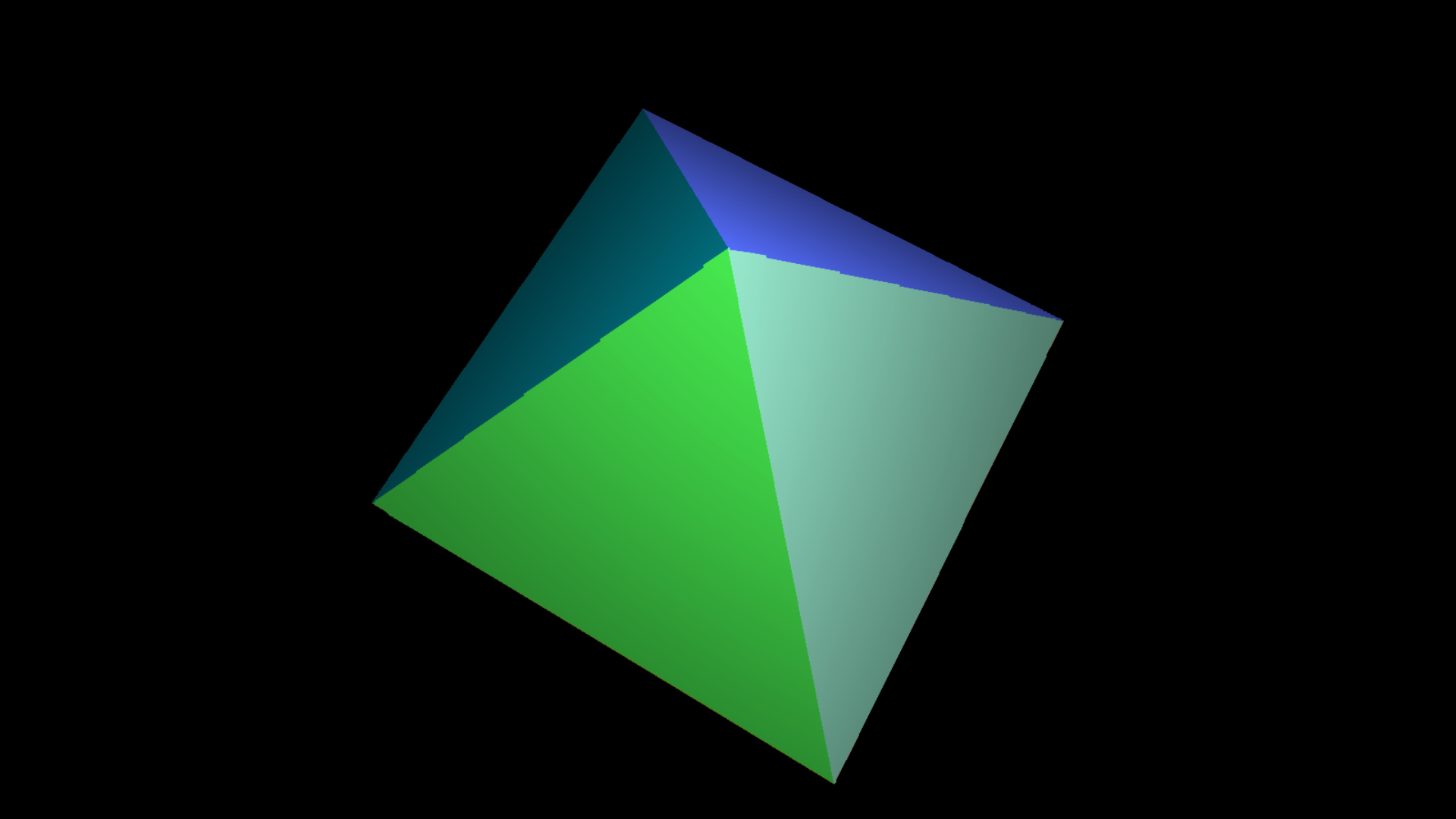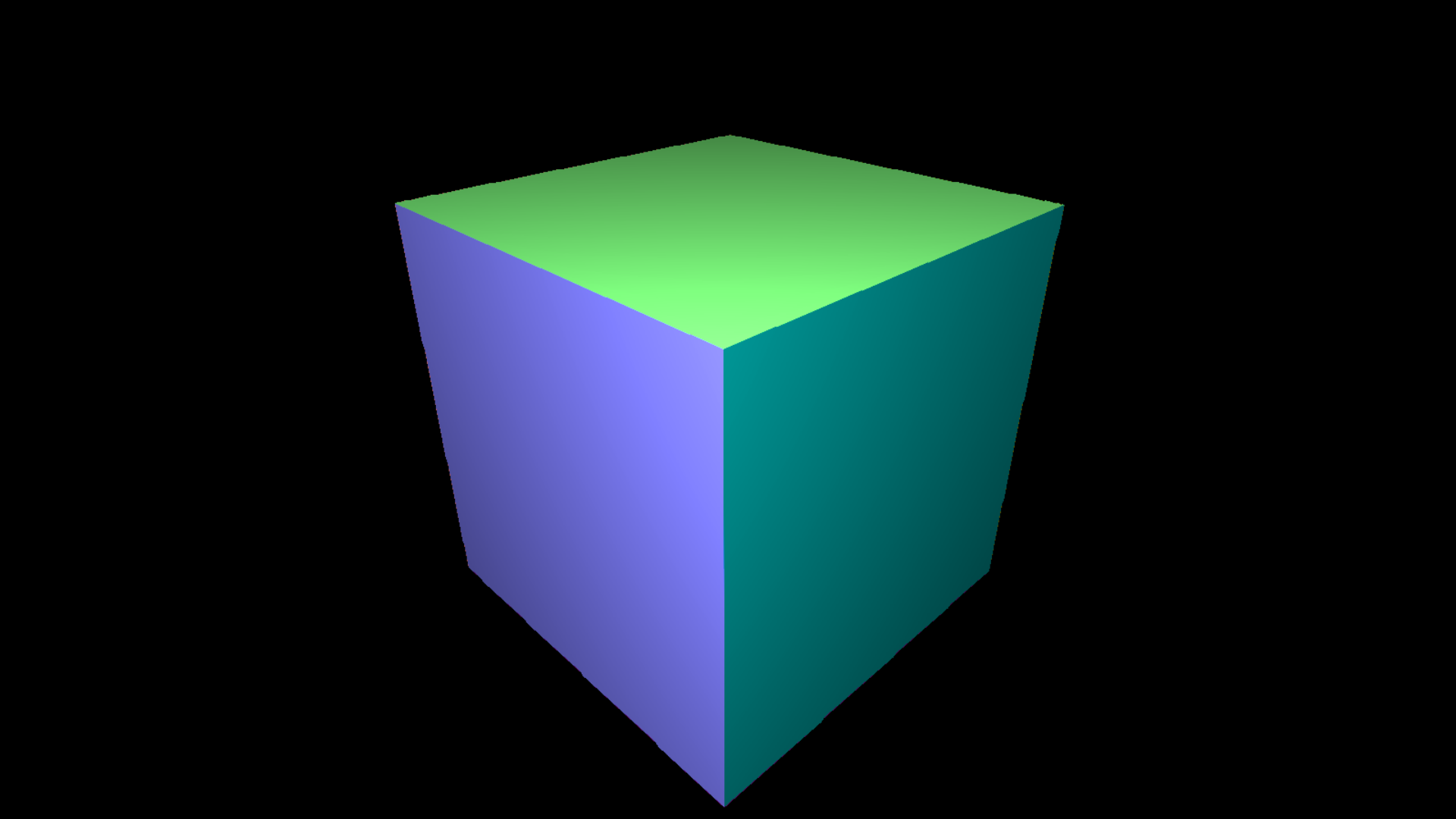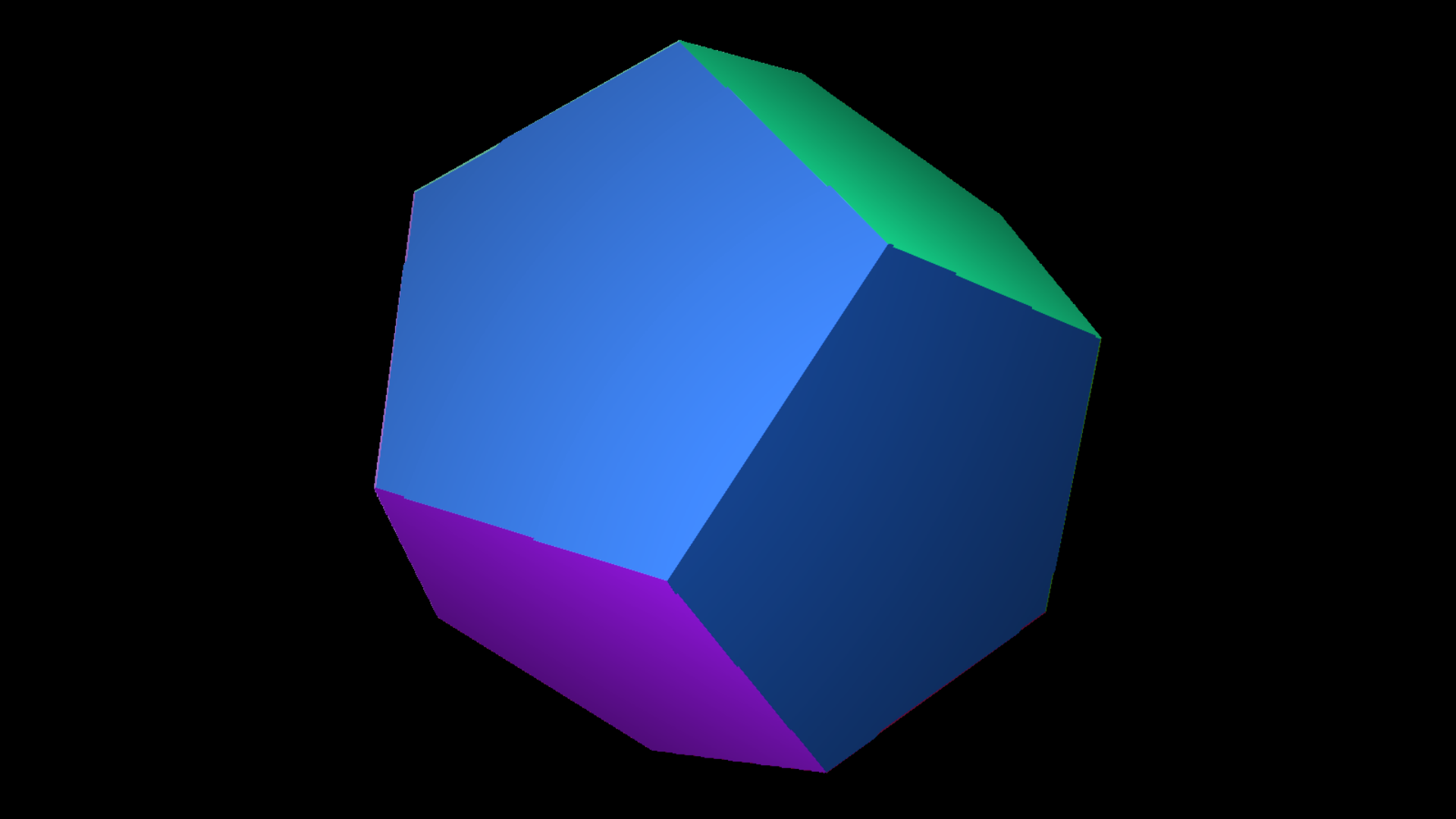
Jump to:
Summary
Platonic Solids
Schläfli Symbols and the Dual
The Rhombic Dodecahedron
4D Platonic Solids
The Animation
More Dimensions
Summary
The 24-cell is a marvelous shape which I have animated at the bottom of this article. It exists in 4
dimensional Euclidean space; it is Platonic, self-dual, space-tiling, and the only shape with all of these
properties that is >2 dimensional. It also happens to be the only Platonic solid that has neither
simplicial faces nor a dual with simplicial faces.
Platonic Solids
In 2 dimensions, a Platonic solid is defined as simply a convex regular polygon - that is, if you draw a line
segment between any two points inside the polygon it will exist strictly inside the polygon (convexity) and all
the edge lengths and angle measures of the polygon are equal (regularity).
In 3 dimensions, a Platonic solid is defined as a polyhedron (3D figure with polygonal faces) whose faces are
all the same Platonic polygon and the same number of edges join at each vertex (vertex transitivity).
Whereas there are infnitely many Platonic polygons (octagon, nonagon, decagon, 11-gon, etc.), there are only 5
Platonic solids. This is actually not too difficult to see; since we know what kind of polygonal faces we are
allowed to use we can just start trying to construct things.
If we start with the simplest regular polygon, the triangle, we notice that we can put 3 around a vertex, fold
into the next dimension, and then add a fourth to close the gap and make a tetrahedron:

If we put 4 triangles around a vertex, fold into 3D space, do the same for another 4 triangles, then put them together, we get an octahedron:

If we put 5 triangles around a vertex, fold into 3D, do the same for another 5 triangles, then put a strip of 10 triangle between them, we get an icosahedron:

We can't do it with more than 5 triangles, because if we put 6 together we don't have any extra room between them to fold into 3D space. If we put 3 squares around a vertex and fold into 3D space we can construct a cube:

Notice that we can't do it with any more than 3 squares for the same reason we can't do it with more than 5 triangles. Now if we put 3 pentagons together we get a dodecahedron:

We can't do the construction with more than 3 pentagons for the same reason as above. If we were to try the construction with regular hexagons we would find ourselves without any room to fold, if we were to try it with any polygon with a greater number of sides, they would overlap. Notice that the fact that the vertices of a Platonic solid must all look the same implies that each number of each polygon around a vertex yields a unique construction.
Schläfli Symbols and the Dual
The Schläfli symbol of a Platonic polygon with $n$ sides is $\{n\}$. So an equilateral triangle is represented
by $\{3\}$, a square by $\{4\}$, etc.
Adding a second number to the list gives us the constructions we were talking about above. Specifically,
$\{n,m\}$ means a shape made of regular $n$-gons where $m$ faces meat at a vertex. You can easily see that the
Schläfli symbols of the solids presented above are $\{3,3\}$, $\{3,4\}$, $\{3,5\}$, $\{4,3\}$, and $\{5,3\}$,
respectively. You can also think of these symbols as representing tilings of the sphere that possess 3D
rotational symmetry - each face of one of the solids corresponds to a tile on the sphere.
The configurations of polygons which couldn't be folded also have Schläfli symbols: $\{3,6\}$ is 6 triangles
meating at a vertex, $\{6,3\}$ is 3 hexagons meeting at a vetex, and $\{4,4\}$ is 4 squares meeting at a
vertex. Since each of these configurations fit together without any room to fold and without any overlap, they
correspond to tilings of the plane. You can also talk about the configurations where two polygons overlap, each
of these correspond to a tiling of the hyperbolic plane.
You might have noticed some duality in the Schläfli symbols of the Platonic solids. If you have a polyhedron
and you construct a new polyhedron by placing a vertex at the center of every face and connecting vertices if
the faces were adjacent, you obtain the dual of that polyhedron. It's intuitive that, if the polyhedron
has a Schläfli symbol, the Schläfli symbol of the dual is the reverse of the symbol for the original (make sure
you're able to justify this to yourself).
Thus, we can see both visually and symbolically that the dual of the tetrahedron is the tetrahedron, the dual
of the octahedron is the cube, and the dual of the icosahedron is the dodecahedron. It's also easy to see that
every regular polygon is its own dual and that the dual of the dual of a polytope (the generalization of
polygons and polyhedra to any dimension) is itself.
The Rhombic Dodecahedron
If we have a cube and we cut it into 6 square pyramids, each going from one face to the center of the cube,
then reflect the direction that each square pyramid is pointing across its square face, we get a rhombic
dodecahedron:

It might be difficult to see how the construction that I described gives us this solid; I would recomend
checking out this
excellent gif, created by Wikipedia editor TED-43. His website
is really cool.
The rhombic dodecahedron has many interesting properties. One is that each of its faces has point symmetry;
reflect the entire solid through the center of any of its faces and you will get the same solid, just
translated (this property makes it a zonohedron).
Another marvelous property is that it can tile all of 3D space. To see this, imagine a uniform tiling of 3D
space by identical cubes, remove half of the cubes to make a 3D checkerboard pattern, now construct a rhombic
dodecahedron out of each of the remaining cubes to fill all of space.
As you may have noticed, the rhombic dodecahedron is not Platonic. Not only are the faces irregular, the
pyramid vertices are the junction of 4 edges and the cube vertices are the junction of 3, so it isn't vertex
transitive.
To see why I brought up the rhombic dodecahdron, we need to go one dimension higher.
4D Platonic Solids
We can begin constructing 4D Platonic solids the same way we constructed 3D Platonic solids, except instead of
putting polygons around a vertex we put solids around an edge.
If we put 3 tetrahedra around an edge, fold into the 4th dimension, then add 2 more tetrahedra we get a
4-simplex, the 4D analogue of the tetrahedron. Its Schläfli symbol is $\{3,3,3\}$ (The last number in the
symbol is the number of 3D solids around an edge).
If we put 4 tetrahedra around an edge and fold into 4D, then do the same thing 3 more times and put them
together, we get an orthoplex, or 4D cross-polytope, the 4D analogue of the octahedron. Its Schläfli symbol is
$\{3,3,4\}$.
If we put 5 tetrahedra around an edge, fold into 4D, then do the same thing 119 more times and put them all
together we get the polytope called the 600-cell. This one is pretty difficult to visualize, I'd direct you to
the wikipedia if you want to see what its
3D projections look like. It's Schläfli symbol is $\{3,3,5\}$.
If we put 3 cubes around an edge and fold into 4D, we can make a tesseract. This one is pretty easy to
visualize, its net is just a 3D cross of cubes. It's Schläfli symbol is $\{4,3,3\}$.
If we put 3 dodecahedra around an edge, fold into 4D, then do the same 39 more times and put them all together,
we get a 120-cell, the dual of the
600-cell. The Schläfli symbol is $\{3,3,5\}$.
Finally, if we take the tesseract and we perform the same construction that we used to get the rhombic
dodecahedron - that is, we make a cubic pyramid going from each face to the center and then invert it - we get
the 24-cell. We can check that the vertices will all look the same: every pyramid vertex will have 8 edges
going to the 8 vertices of one of the faces, and every vertex of the cube will be connected to 4 cube vertices
and 4 pyramid vertices for a total of 8. We can also check that the faces are regular: if the vertices of the
cube are $(\pm 1,\pm 1,\pm 1,\pm 1)$ then each vertex is 2 away from the origin and 2 away from its neighbors;
the cubic pyramids that we make will have square pyramid faces with equilateral triangle faces, so when we
perform the reflections we will get equilateral octahedra as faces of the 24-cell! Indeed, if we put 3
octahedra around an edge then fold we will be able to make a 24-cell; this is why the 24-cell is sometimes
called an octaplex, short for octahedral complex. Thus, the Schläfli symbol of the 24-cell is $\{3,4,3\}$,
meaing it is self-dual! This is the only self-dual Platonic solid except for the simplex (and polygons). Aside
from being both Platonic and self-dual, it tiles 4D space for the same reason the rhombic dodecahedron tiles 3D
space!
By the way, using the construction we employed for the rhombic dodecahedron and 24-cell, we can see that the
24-cell is also 8 orthoplexes put together. Thus, the orthoplex also tiles space!
The Animation
Because the tips of the pyramids that are attached to the faces of the tessearact are the vertices of an
orthoplex, it is very easy to render an octaplex, orthoplex, and tesseract all with the same code.
Each of the polytopes is rendered as an orthographic projection of its edges. If we had 4 primary colors, I
could communicate to you all 4 coordinates of each of the vertices of the polytope via its color. Unfortunately
we have only 3 primary colors, but since each polytope is convex and compact all the vertices lie on a 3-sphere
embedded in $\mathbb{R}^4$. This is convenient because it means we can use Lambert-Azimuthal
projection to take the vertex from a position in 4D space to a position in rgb space (which happens to
preserve volume until we scale it down to actually fit in the correct range for the colors). The actual color
of a pixel is a linear interpolation between the colors of two vertices based on the distance from the pixel to
the orthographic projections of each of the vertices.
In 3 dimensions, it's easy to understand why specifying a rotation about the origin takes 3 parameters: 2 to
choose the axis and 1 to choose the angle. In higher dimensions, it becomes necessary to note that rotations
actually occur in planes - in 3D, a plane through the origin specifies an axis through the origin, which isn't
true in higher dimensions. There is another way to think about this: there are three planes we can make using
three axes, and any rotation can be decomposed into a rotation through each plane. In 4D, we have all of the
planes we had in 3D plus 3 new ones that we get by combining the new axis with each of the old ones for a total
of 6 degrees of rotational freedom. 2 of the degrees of freedom are controlled by the mouse (hover over the
animation) and the other 4 are specified by time and each of the sliders. The rotations are computed using 4D
Euler angles since using quaternions in this context would make for somewhat unintuitive sliders.
Click "play" to display the animation, click the image to toggle the interactivity on and off.
Velocity 1 = 0.1
Velocity 2 = 0.2
Velocity 3 = 0.3
Velocity 4 = 0.4
More Dimensions
In order to construct Platonic solids in dimension 5, we need to use the Platonic solids of dimension 4.
Specifically, we need to be able to put at least 3 of the same 4-polytope around a 2-dimensional facet. This
means that the angle between the faces of the polytope must be $< \frac{2\pi}{3}$. Unfortunately, this is only
the case for the tesseract and 4-simplex. In 5 dimensions, you can make a 5-cube by putting 3 4-cubes
around a 2-face. You can make a 5-simplex by putting 3 4-simplices around a 2-face, and a 5-orthoplex by
putting 4 4-simplices around a 2-face. This is the case in all higher dimensions as well; the only Platonic
solids are the simplex, measure polytope (hypercube), and cross polytope
(orthoplex/octahedron analogue).
Note that the simplex is always self-dual, and that the measure polytope is always dual to the cross
polytope. The simplex and the cross-polytope have simplices as faces; this makes it apparent that the
24-cell, since it has octahedral faces and is self-dual, is the only Platonic solid that has neither
simplicial faces nor a dual with simplicial faces